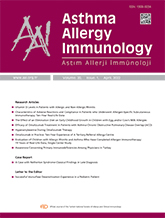


Objective: Allergen-specific subcutaneous immunotherapy (SCIT) is known as the best therapeutic method that may alter the natural course of allergic diseases, compared to pharmacological and avoidance options. However, some problems such as adverse reactions (ARs), inconvenience, and high costs of a prolonged course of therapy may prevent patients from completing the therapy. The objective of this study was to evaluate the evidence for the potential barriers against the benefits of SCIT in adult patients.
Materials and Methods: An observational study between 2009 and 2019 was performed at the Allergy Clinic of a tertiary hospital. The data of 166 adult patients who underwent SCIT for allergic rhino-conjunctivitis (ARC), and/or asthma or hymenoptera venom anaphylaxis using conventional schedules with standard allergen extracts were evaluated.
Results: SCIT indications were ARC (63%), ARC and asthma (19.3%), and venom anaphylaxis (17.5%). The standardized allergen extracts used were grass pollen (59%), house dust mite (19.9%), and hymenoptera venom (17.5%). The frequency of SCIT-related ARs was 7.4% per injection, and 42.2% per patient. Local ARs were more frequent than systemic ARs (SAR)s. The majority of the SARs were composed of anaphylaxis and generalized urticaria, which were mostly of moderate severity with no deaths. SARs were more common in women, in patients with high injection numbers, and in patients under SCIT with cat allergen or multiple allergens. Most of the SARs occurred immediately after injection, and in the initial phase, whereas the delayed-type of SARs was common in patients with pollen SCIT. Three patients under cat SCIT discontinued treatment due to SARs of immediate and moderate/severe type. Ratios of SARs of venoms were insignificantly higher than aeroallergens. SARs with house dust mite SCIT were rare. Rates of patients` compliance to SCIT were similar between the allergen extracts, with an average of 70%. The most common causes of non-compliance were non-adherence, leaving the current residence, difficulty in obtaining the allergen extracts, and ARs. The frequencies of local and moderate ARs were higher in compliant patients, whereas systemic and severe ARs were higher in non-compliant ones. In the regression model, it was found that ARs increased and patient compliance decreased as the number of injections increased.
Conclusion: This study in the real-life setting for a decade showed that less than half of the patients that underwent SCIT had developed ARs, which were generally local and of moderate severity. In conclusion, these results indicated that each allergen of SCIT had different characteristics of ARs, and the moderate incidence of ARs was not a problem regarding compliance with SCIT. Therefore, SCIT may be preferred in indications of allergy, and has a tolerable balance of ARs and safety.